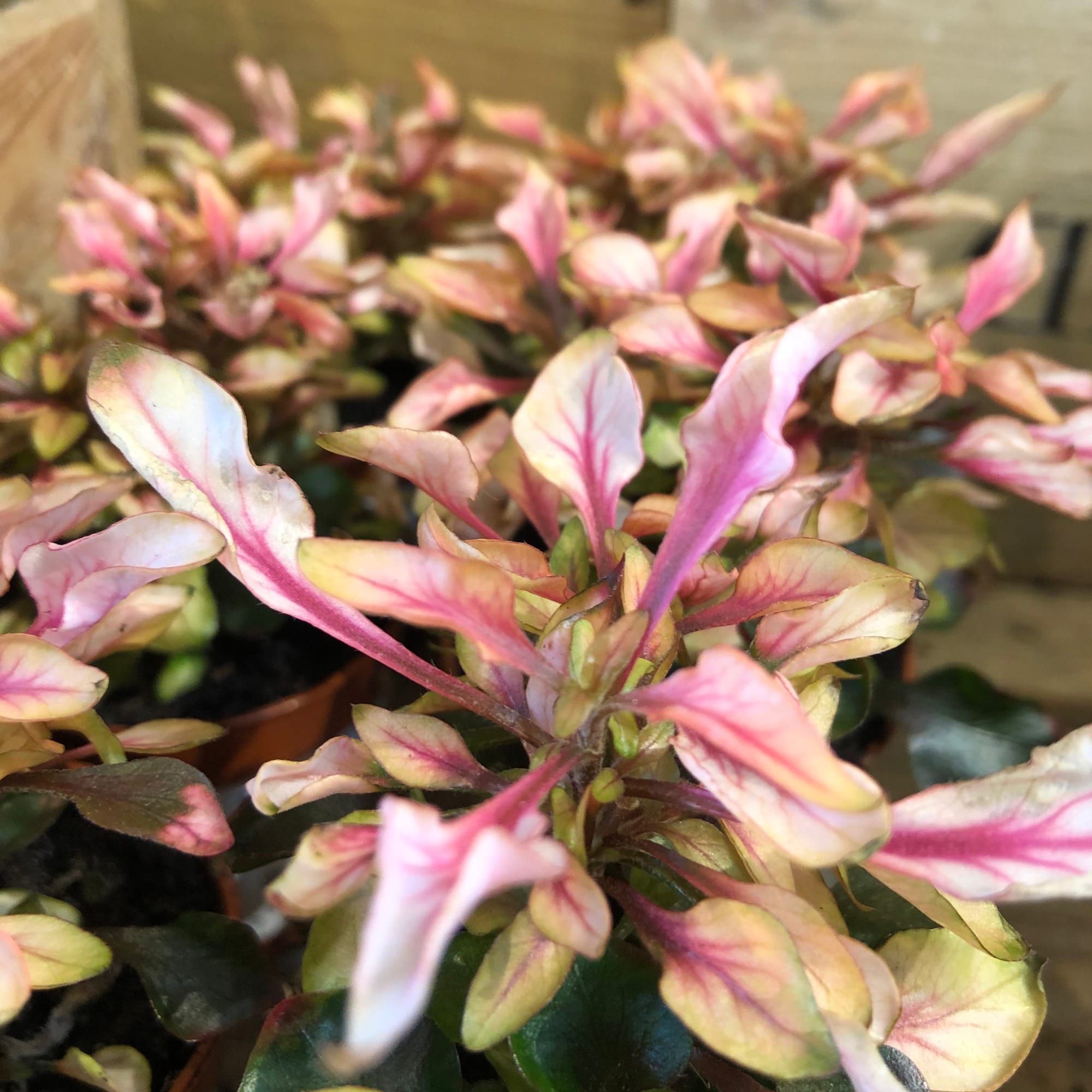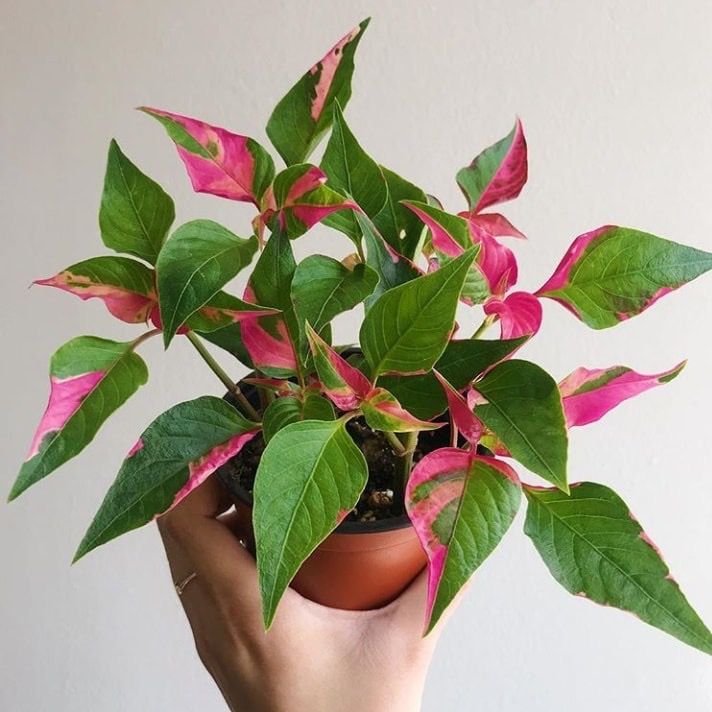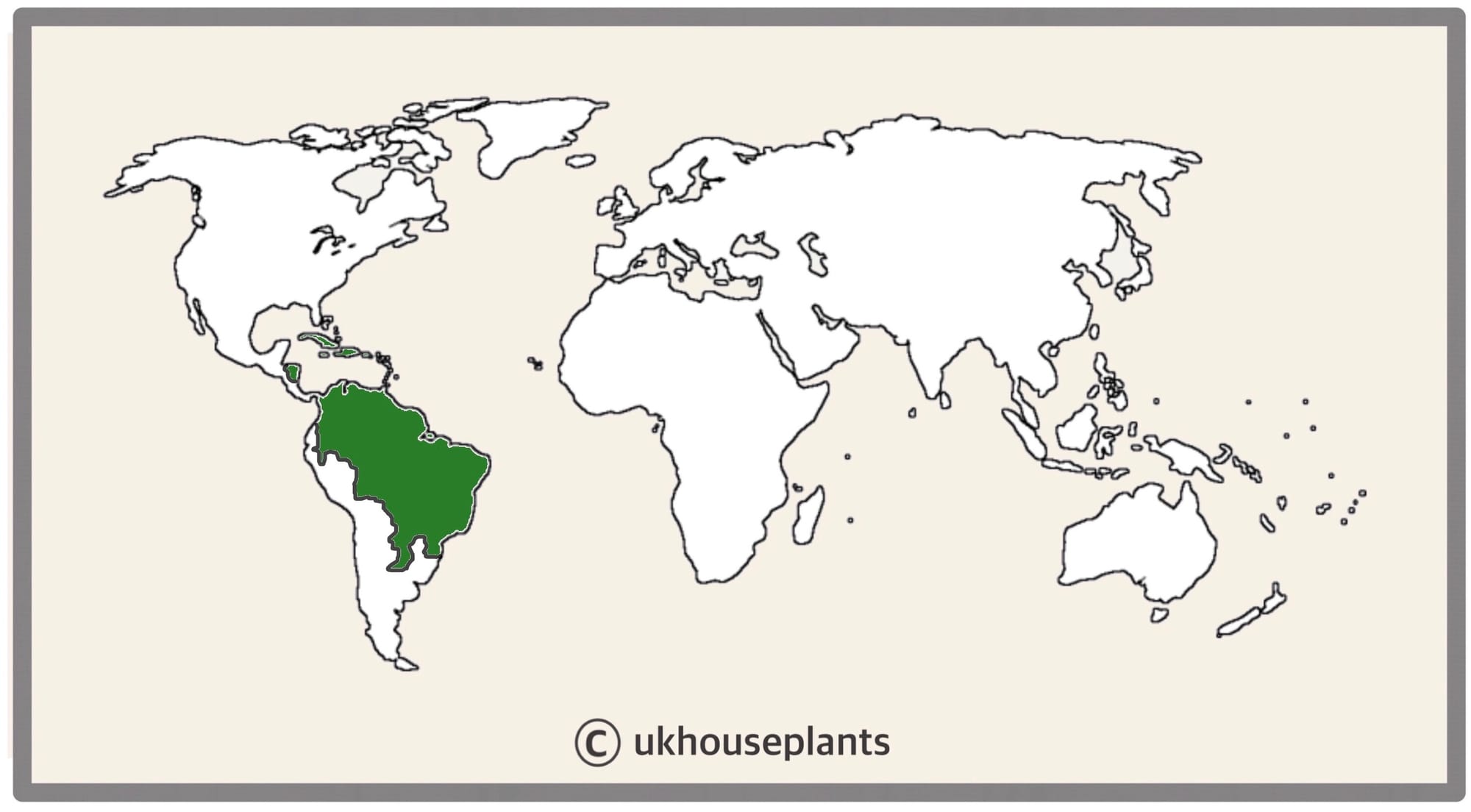
Contents
- Top Tips
- Location, Water, Humidity & Fertilisation
- Common Issues
- Origins, Temperature, Propagation, Repotting & Toxicity.
Need the answer to a specific plant query? Book a 1-to-1 video call with THE HOUSEPLANT DOCTOR™, the website's friendly author, to overcome and address your niggling problem! Available on iMessage, WhatsApp, Facebook Messenger & more.
Top Tips & Info
- Care Difficulty - Easy to Moderate
- Indoor Alternanthera will need to be kept in a relatively bright area, away from deep shade or draughty/cold conditions. Remember not to over-expose your specimen to the sunlight; we'd recommend a north-facing window to provide bright, indirect light still, but without the risk of sun-scorch.
- Allow the soil's top third to dry out in between waters, reducing this slightly in the winter months. Avoid excessive dehydration as the risk of crisping foliage, stunted growth and eventual plant death is always a risk factor for Alternanthera.
- Fertilise using a 'Houseplant' labelled feed every four waters in the spring and summer, reducing this to every six in the colder months.
- Transplant every three years using a 'Houseplant' labelled compost and the next sized pot with drainage holes.
- As this species is classed as 'Monocarpic', it'll only flower once in its lifetime, within three years of ownership. Scroll down to the final paragraph in 'Common Issues' to learn more about prolonging its life for longer.
Location & Light - 🔸🔸🔸
The amount of light and the current season of the year will directly govern the frequencies of waters per month. Specimens placed in darker areas must be kept on the drier side to life, whereas brighter locations will require more soil moisture to lubricate photosynthesis.
We'd recommend keeping your indoor Alternanthera in the warmest and brightest possible location without the risk of direct sunlight. Although a north-facing windowsill is best, you can still keep the specimen in either an east or west-facing windowsill, as long as you keep an eye out for dry soil. Within a foot of an LED grow-light, or two feet away from a non-LED grow-light is also brilliant for good, quality growth.
Water - 🔸🔸
This species must be kept in reliably moist soil, as inconsistent moisture levels may result in crisped growth and an unhappy plant. Allow the compost's top third to dry out between waters in the growing period, reducing this slightly in the autumn and winter to replicate its dormancy. Under-watering symptoms include dehydrated foliage, leaf-plantlet death & browned areas forming on the leaf edges. These issues are usually caused by too much light/heat or just forgetfulness - remember, the brighter the location, the more watering you'll need to do. Over-watering symptoms include the central foliage beginning to yellow rot, little to no new growth, yellowing lower leaves and eventual plant death. If you feel that over-watering is to blame for its demise, click here to learn more about root rot and how to address it.
Humidity - 🔸🔸
Average room humidity is enough to satisfy this plant, as long as you don't live in an overly-dry climate. Never situate it within a few metres of an operating radiator due to the enriched chance of browning leaf-tips. If you are indeed worried about dry air, create a humidity tray to provide a moist and stable environment for your plant, which will also have the added benefit of slowing the rates of drying soil!
Fertilisation - 🔸🔸
Fertilise every four waters during the growing period before reducing this to every six in the autumn & winter. Although an 'All-Purpose' fertiliser will still do the job, we'd recommend using a specific 'Houseplant' labelled fertiliser as it'll support the vital thirteen nutrients that this species will need to grow.
If you're interested in achieving flowers, use a fertiliser high in potassium ('Tomato' labelled feed is good) for the stimulation of flower buds - just remember that most Alternanthera will begin to decline shortly after blooming.
 Alternanthera ficoidea 'Party Time'
Alternanthera ficoidea 'Party Time'
Common Issues with Alternanthera Ficoidea
Overly green juvenile growth is caused by too little light. Move the plant into a brighter area within reach of direct sunlight, but without the risk of being scorched to stimulate better colourful growth. Extreme variegations that hinder the plant from developing chlorophyll (green pigmentations) are typically caused by too much sunlight, which will quickly result in sun-scorch.
Root or basal rot is a common issue among specimens sat in too dark environments with prolonged soil moisture. Symptoms include rapidly yellowing leaves, mouldy soil, stunted growth and a rotten brown base. Take the plant out of the pot and inspect health below the soil line. If the roots sport a yellow tinge, you're good to go, but if they're brown and mushy, action must be taken immediately. Learn more about addressing root rot on this link.
Curled leaves and brown leaf-edges are the result of too little water and over-exposure to the sun. Indoor Alternanthera are best located in bright, indirect settings, and those that haven't acclimatised to the harsh rays will show signs of sun-scorch and environmental shock. A splash of winter sunlight is acceptable as long as the soil moisture is regularly observed, with complete avoidance once summer comes along.
If your specimen is located in a dark environment with mould developing on the compost's top layer, use a chopstick to stab the soil in various areas gently. You should aim to enter the compost between the base of the plant and the pot's edge, as failure to do so may lead to damaging its lower portion. Leave the holes open for a few days before re-surfacing the soil to avoid it becoming overly dry. Not only will the gentle shift in the soil's structure mimic the work of small invertebrates in the wild (worms, etc.), but it'll also add oxygen back into the soil, thus reducing the risk of root rot. Repeat this monthly, or whenever you feel the potting-mix isn't drying out quickly enough.
When this species is severely dehydrated, most of its leaves will crisp-up and fall off - leaving you with a naked plant. Although it may spell the end of juvenile plantlets, there may still be light at the end of the tunnel for more established specimens. If its stem is still plump without any signs of retraction, prune-away the severely affected areas and contain the plant (with its pot) in a transparent bag that has small holes. Keep the soil continually moist, providing a good level of indirect light and temperatures above 15°C (59°F). After a few weeks, new life will form in the nodal junctions on the stems, signalling the start of its recovery process. Maintain a sealed environment for the following month until you feel it's necessary to release it back into the open air. For the prevention of environmental shock, be sure to introduce a humidity tray for higher levels of atmospheric moisture around the plant in its new setting. Not only will this ease the specimen back into healthy functioning life, but it'll also reduce the rate of transpiration (water-loss in the leaves), and therefore downplay the risk of dehydration and further decline.
Shortly after the flowering period, your specimen is likely to begin withering away. Most Alternanthera would have served their sole purpose in life, which is reproduction. Plants regarded as 'Monocarpic' will bloom only once during their lifetime, regardless of whether it takes thirty years or one to complete its lifecycle. Especially after successful pollination, the leaves may begin to yellow and wilt over, followed by basal rot that'll spell the end of its life. Although this process should take around two to five years to complete, some specimens will reach maturity within two years before developing their first flower. If you're interested in prolonging your Alternanthera's life, cut off any flower-shafts or unopened buds that'll usually develop at the tips of each stem. Keep the specimen in a warm, bright location and regularly feed it with a 'Houseplant' labelled fertiliser to optimise its health. Lowered temperatures may quicken its rate of death or decline, so tricking it into warmer and consistent temperatures throughout the year is highly recommended. Take stem cuttings (before it produces the flower-stalk, which will be located at the tips of each stem) via water to maintain a small collection of Alternanthera plants. Scroll down to 'Propagation' to learn more.
Origins
Carl Linnaeus first documented the species in 1753, during a voyage to the Americas, naming it Gomphrena ficoidea. The specific epithet, "ficoidea", refers to the similarities of its fruits to the figs produced by some Ficus. The species was then transferred into its current genus of Alternanthera, first penned by French botanist Ambroise Marie François Joseph Palisot de Beauvois in the 1810s. It has natural distributions across Central and South America and has been recently introduced to Australia, India, Palau and Vietnam in the last two centuries.
 The Distribution of Alternanthera ficoidea.
The Distribution of Alternanthera ficoidea.
Temperature
15° - 24°C (59° - 75°F)
H1a (Hardiness Zone 13) - Must be grown indoors to maintain foliage all year round. Although indoor Alternanthera can withstand temperatures down to 12°C (54°F), they could produce flowers and most likely die shortly afterwards, as they cannot tolerate cool periods for long. If you maintain consistent temperatures of 18°C (64°F) throughout the year, you'll reduce the risk of flower development and therefore plant death in the autumn and winter - scroll up to 'Common Issues' to learn more about its lifespan. A domestic specimen can live for up to four or five years.
Spread
Depending on the species, most indoor Alternanthera will grow up to 0.4m in height and 0.25m in width once they reach maturity. The ultimate height will take between 3 - 5 years to achieve, with up to 10cm of new growth per year.
Pruning & Maintenance
Remove yellow or dying leaves, and plant debris to encourage better-growing conditions. While pruning, always use clean scissors or shears to reduce the chance of bacterial and fungal diseases. Never cut through yellowed tissue as this may cause further damage in the likes of diseases or bacterial infections. Remember to make clean incisions as too-damaged wounds may shock the plant, causing weakened growth and a decline in health.
As Alternanthera is classed as 'Monocarpic', it's very likely for your specimen to die shortly after the flowering period. If you'd like to help extend its lifespan, pinch off any developing flower buds before they open, using your hands. Keep the specimen in a warm, bright location and maintain evenly moist soil. This should considerably elongate your specimen's life.
Propagation
Seed & Stem Tip Cuttings.
Seeds (Easy & Recommended) - Soak the seeds in lukewarm water for around 24hrs in a dark location, preferably on top of an operating radiator. The best soil to use is a ‘Houseplant’ labelled potting mix; however, 'Multipurpose' compost with added perlite and sand is as good. Set the seeds around 0.5cm (0.2 inches) deep, resisting the temptation to compact them. Sprinkle a thin layer of vermiculite over the soil to lock-in the soil moisture. Maintain evenly moist soil and allow the excess water to freely drain from the pot's base to prevent water-logged conditions. The ideal location for successful germination is in a bright, indirect setting with temperatures above 18℃ (64℉) with bottom-heat. Keep the pot in a transparent bag to provide a stable level of humidity, along with longer-lasting soil moisture. Germination may take up to two months, so don't discard any unsuccessful seeds until this threshold has been surpassed. Remove the bag once the seedlings produce their second leaf and then split them into their own 5cm (2 inches) pots.
Stem-Tip Cuttings (Easy to Moderate) can be taken at the start of spring, when specimens surpass 10cm in height. Prune the top 6cm (2.5 inches) of the leading stems, with at least five nodes (leaves) - the top two for foliar growth and the others for root development. Gently remove the lower two leaves and set the cutting's bottom half into lukewarm water. Provide a bright, indirect windowsill and replace its water once a week to alleviate basal rot. After around a month or two, you'll notice some roots develop from the base of the plant, and once they are at least 3cm (1.2 inches) in length, you can safely transplant it into moist compost. Although we'd recommend using a 'Houseplant' labelled soil, a 'General-purpose' compost with added perlite will work wonders, too. Fill the bottom 1/3 of a 7cm pot, with your chosen potting mix. Place the cutting onto the soil, filling the remaining gaps with the remaining compost. Ensure you don't submerge its leaves into the soil, as they'll simply rot and weaken the specimen's overall health. Continue to provide a bright, indirect location with reliable soil moisture to quicken the rate of root and leaf development. Keep an eye on it closely for the next month, following the care advice provided above!
Flowers
As this species is part of the Amarantha family (Amaranthaceæ), it'll produce small pompom-like flowers throughout the spring or summer. In this species' case, you'll notice an elongated stem that'll house several clusters of small white flowers, lasting several days once opened. Because indoor Alternanthera are 'Monocarpic' (Annuals, the chance of your specimen dying shortly after the last bloom is quite likely, so prune off any flower buds to reduce this risk.
Alternatively, for those interested in the best possible show of blooms, keep the specimen well hydrated, along with regular fertilisation to stimulate longer-lasting flowers. We'd recommend using a potassium-based feed, like a 'Tomato' food, every three waters to maintain evenly fertile soil. Once the final bloom wilts, cut the foliage back by a third to stimulate new lower leaf buds.
Repotting
Repot your specimen only twice in its lifetime (best done in spring), using a 'Houseplant' labelled compost and the next sized pot with drainage holes. Hydrate the plant 24hrs before tinkering with the roots to prevent the risk of transplant shock. For those that are situated in a darker location, add a thin layer of small grit in the pot's base to improve drainage and downplay over-watering. Click here for a detailed step-by-step guide on transplantation, or via this link to learn about repotting with root rot.
Book a 1-to-1 video call with THE HOUSEPLANT DOCTOR™ if you'd like a personal guide to repotting your houseplant. This will include recommending the right branded-compost and pot size, followed by a live video call whilst you transplant the specimen for step-by-step guidance and answer any further questions!
Pests & Diseases
Keep an eye out for mealybugs, aphids, spider mites, whitefly, blackfly & vine weevils that'll locate themselves in the cubbyholes and undersides of the leaves, with the exception of the latter in soil. Common diseases associated with this species are root rot, leaf-spot disease, Peronospora, botrytis, rust, powdery or downy mildew & southern blight - click here to learn more about these issues.
Toxicity
Not known to be poisonous when consumed by pets and humans. If large quantities are eaten, it may result in vomiting, nausea and a loss of appetite.
Retail Locations
Blue Diamond (Occasionally) & Online Stores.
Book a 1-to-1 Call with THE HOUSEPLANT DOCTOR™
If you need further advice with your houseplants, book an advice call with ukhouseplants' friendly and expert writer today! This can be done via a video or audio call on most apps, including Facebook, FaceTime & Skype. A ten-minute call costs £6.95 (US$8), or £15.95 for thirty minutes. You can ask multiple questions, including queries on plants, pests, terrariums, repotting advice and anything in between. Please consider supporting this service to keep ukhouseplants thriving!